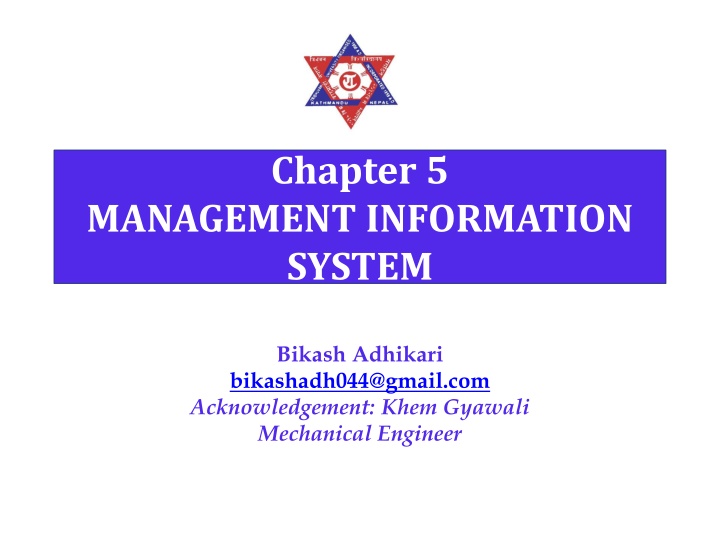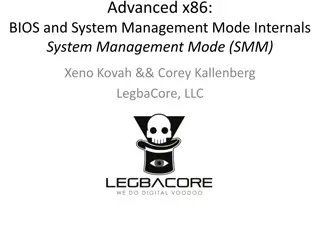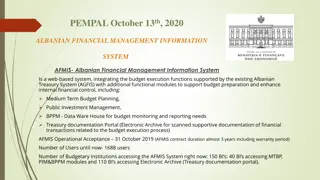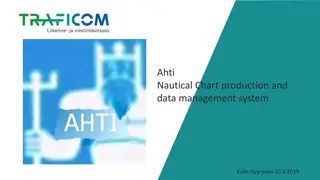
Management Information Systems: Data, Information, and Importance
Explore the fundamentals of Management Information Systems (MIS) including data, information, system components, and the role of MIS in organizational decision-making. Learn about the qualities of good information, the needs, functions, and importance of MIS in different functional areas of management.
Download Presentation

Please find below an Image/Link to download the presentation.
The content on the website is provided AS IS for your information and personal use only. It may not be sold, licensed, or shared on other websites without obtaining consent from the author. If you encounter any issues during the download, it is possible that the publisher has removed the file from their server.
You are allowed to download the files provided on this website for personal or commercial use, subject to the condition that they are used lawfully. All files are the property of their respective owners.
The content on the website is provided AS IS for your information and personal use only. It may not be sold, licensed, or shared on other websites without obtaining consent from the author.
E N D
Presentation Transcript
Chapter 5 MANAGEMENT INFORMATION SYSTEM Bikash Adhikari bikashadh044@gmail.com Acknowledgement: Khem Gyawali Mechanical Engineer
Management Information System course outline Data and Information Need, function and Importance of MIS Evolution of MIS Organizational Structure and MIS Computers and MIS Classification of Information Systems Information Support for functional areas of management Organizing Information Systems 2
Management Information System Management: The direction of enterprises toward the achievement of a predetermined objectives. It is carried out by managers. Information: An aggregate of facts so organized as to provide knowledge. It is an output obtained by processing data as input. System: An assembly of procedure, processes, methods or techniques united by some form of regulated interaction to form an organized whole. Management Information System (MIS) can be defined as a system of obtaining, abstracting, storing and analyzing data (new facts) to produce information for use in planning, controlling, and decision making by yielding information for managers, at the time they can most effectively use it . 3
1. Data and Information Data: Un interpreted raw statement of facts. Group of non-random symbols (works, valves, figures) which represent things that have happened . Obtained by research or observation. Eg. Payroll, bank statement etc. Information: Aggregate of facts so organized as to provide the desired knowledge. Data that have been interpreted and understand by the recipient of the message. Can have different meaning to different people. 4
1. Data and Information Difference between Data & Information Data (Input) Information (Output) Processing Feedback/ Control 5
1. Data and Information Qualities of Good Information 1. Accuracy 2. Timeliness 3. Completeness 4. Conciseness 5. Relevancy 6. Frequency 7. Understandable 6
2. Need, Function and Importance of MIS Needs: Production managers: production costs, labor costs, machine costs, overhead costs. Marketing managers: new product development, new product sales trend, selling costs, market research. Personnel managers: work forces turnover, absenteeism, employ skill level, labor markets, wage level. 7
2. Need, Function and Importance of MIS Functions: 1. Determination of information needs. (How much? How, when and by whom? What?) 2. Evaluation. ( How much confidence?) 3. Abstraction. ( Editing and reducing incoming information) 4. Dissemination. ( information to the right manager at the right time) Getting the right 8
2. Need, Function and Importance of MIS Importance: 1. Provides relevant information available in the right form at the right time. 2. Bring the new facts to the knowledge of the management. 3. Supply the desired information at a reasonable cost. 4. Keep the information up to date. 5. Store the important and confidential information properly for utilizing it for decision-making whenever required. 6. Focus on those decisions where benefit/cost ratio is attractive. 7. Supply reliable and logical data. 8. Provide data for carrying out the major management functions. 10
3. Evolution of MIS Digital computers 1959, Electronic data processing (EDP) Focus on record keeping Card punching machine Computer languages Personal computers Direct end user involvement Steady performance User friendly and graphical user interface. Design support system (DSS) Operation research Executive information system (EIS) 11
4. Organizational Structure and MIS The nature of organizations determines their activities, the information support they need, and the type of information systems they use profit-making business versus not-for-profit organizations exist manufacture goods versus services are delivered can be located in one place or in several places, some are global or multinational organizations MIS has been described as a pyramidal structure, with four levels of information resources. The levels of information would depend upon the organizational structure. 12
4. Organizational Structure and MIS The top level supports strategic planning and policy making at the highest level of management. The second level of information resources aid tactical planning and decision making for management control. The third level supports day-to-day operations and control. The bottom level consists of information for transaction processing. It then follows that since decision making is specific to hierarchical levels in an organization, the information requirements at each level vary accordingly. concepts of organization; organizational theories, principles, structure, behavior and processes such as communication, power and decision making; and motivation and leadership behavior. Thus, MIS as a support system draws upon: 13
5. Computers and MIS Computers are means of management information system. With the use of computers MIS will be efficient and effective. But, the mere fact of using a computer does not itself mean that work is done more efficiently. It is also not necessary that better information is produced. Very often computers are introduced in an attempt to solve technical problem when the real problem is one concerned with management or other things. It is therefore essential that problems are clearly identified before a computer system is used. For clarity, the use of computers will be outlined in two broad categories: The routine processing of day-to-day transactions, known as data processing or transaction processing. The use of computers by the end-users themselves. The end users include mangers, accountants, office staff, sales people, executive and others. 1. 2. 15
5. Computers and MIS Both data processing and end-user computing produce management information. The key difference is that data processing systems supply pre determined outputs and reports so there is less flexibility. This means that great care must be taken in analyzing managements real information needs before the system is designed. On the other hand with end-user computing there is more flexibility and interaction so that the emphasis becomes one of supporting the end user rather than the production of a specified report. and determining 16
6. Classification of Information Systems An information system is a collection of hardware, software, data, people and procedures that are designed to generate information that supports the day-to-day, short-range, and long-range activities of users in an organization. Information systems generally are classified into four categories: Transaction Processing Systems (TPS) Management Information Systems (MIS) Decision-Support Systems (DSS) Executive Support Systems (ESS) 17
6. Classification of Information Systems Transaction Processing Systems A transaction processing system (TPS) is an information system that captures and processes data generated during an organization s day-to-day transactions. A transaction is a business activity such as a deposit, payment, order or reservation. Basic business systems that serve the operational level. A computerized system that performs and records the daily routine transactions necessary to the conduct of the business. Today, most transaction processing systems use online transaction processing. Some routine processing tasks such as calculating paychecks or printing invoices, however, are performed more effectively on a batch basis. activities, many organizations still use batch processing techniques. For these 18
6. Classification of Information Systems A Symbolic Representation for a Payroll TPS 19
6. Classification of Information Systems Management Information Systems (MIS) Management level Inputs: High volume transaction level data Processing: Simple models Outputs: Summary reports Users: Middle managers Example: Annual budgeting A management information system, or MIS (pronounced em-eye-ess), is an information system that generates accurate, timely and organized information so managers and other users can make decisions, solve problems, supervise activities, and track progress. Because it generates reports on a regular basis, a management information system sometimes is called a management reporting system (MRS). An MIS generates three basic types of information: detailed, summary and exception. Detailed information typically confirms transaction processing activities. A Detailed Order Report is an example of a detail report. Summary information consolidates data into a format that an individual can review quickly and easily. To help synopsize information, a summary report typically contains totals, tables, or graphs. An Inventory Summary Report is an example of a summary report 20
6. Classification of Information Systems Decision-Support Systems (DSS) Management level Inputs: Transaction level data Processing: Interactive Outputs: Decision analysis Users: Professionals, staff Example: Contract cost analysis A decision support system (DSS) is an information system designed to help users reach a decision when a decision-making situation arises. A variety of DSSs exist to help with a range of decisions. A decision support system uses data from internal and/or external sources. Internal sources of data might include sales, manufacturing, inventory, or financial data from an organization s database. sources could include interest rates, population trends, and costs of new housing construction or raw material pricing. managers, can manipulate the data used in the DSS to help with decisions. Data from external Users of a DSS, often 22
6. Classification of Information Systems Voyage-estimating decision-support system 23
6. Classification of Information Systems EXECUTIVE SUPPORT SYSTEMS (ESS) Management level Inputs: Aggregate data Processing: Interactive Outputs: Projections Users: Senior managers Example: 5 year operating plan An expert system is an information system that captures and stores the knowledge of human experts and then imitates human reasoning and decision-making processes for those who have less expertise. Expert systems are composed of two main components: a knowledge base and inference rules. combined subject knowledge and experiences of the human experts. The inference rules are a set of logical judgments applied to the knowledge base each time a user describes a situation to the expert system. A knowledge base is the 24
6. Classification of Information Systems Model of a Typical Executive Support System 25
6. Classification of Information Systems Integrated Information Systems With today s sophisticated hardware, software and communications technologies, it often is difficult to classify a system as belonging uniquely to one of the five information system types discussed. today s application software supports transaction processing and generates management information. Other applications provide transaction processing, management information, support. Although expert systems still operate primarily as separate increasingly are consolidating their information needs into a single, integrated information system. Much of and decision systems, organizations 26
6. Classification of Information Systems Interrelationships among systems 27
7. Information Support for functional areas of management 28
THANK YOU!!! 31




















